My painting method for my paper maché skull masks and other projects
Published by Manning on June 19th, 2015
I use basically the same process for all of my big paper maché skull masks, and a lot of my other big paper maché Halloween projects and stuff as well. Here are the materials I use:
- gesso — the spray kind or brush-on kind
- Montana Golden acrylic spray paint (paid link)
- Acrylic paint (like normal paint you apply with a paintbrush)
- An old sponge
- Several different sized paintbrushes
- Clear matte spray
- Plastic plates for mixing paints
- Plastic cups for rinsing brushes
- Plastic shower curtain to protect my outdoor work area
- Newspaper and wax paper to protect my indoor work area
I often start with a coat of Krylon gesso spray (paid link) on the exterior — or sometimes Golden acrylic gesso (paid link) if the weather is bad and I have to work indoors. The spray gesso is a lot faster! Gesso can help smooth out the texture of your paper maché mask or sculpture and help conceal the torn paper edges a bit. Anyway, this step is totally optional! It’s really only important if you’re going for the smoothest texture possible.
(Above: finished Axe Man skull sculpture sporting a fresh coat of gesso, next to his oversized paper maché axe.)
I let the gesso set for a day before continuing. Then, if it’s a mask I’m working on, the next thing I do is spray paint the interior black. This might sound unnecessary, but I like the mask to look good from any angle, whether I’m wearing it or not. If you leave the interior with visible newsprint, people will be able to see it from some angles, like if the mask is on display up on a shelf. I prefer to paint it all black inside.
I always use Montana Golden acrylic spray paint (paid link) for all my commission projects and any of my more-serious personal projects like my Mardi Gras skull masks; it’s the best-quality spray paint I’ve worked with. I go through several cans of their shock black (paid link) and shock white (paid link) every year.
I let the black spray paint set for a couple hours before continuing. Once the interior is dry, I spray paint the exterior white (again, assuming we’re talking about a skull mask here). Now, here’s a funny thing — the exterior is already white since I applied a coating of gesso, and this makes it hard to know what areas you’re covering with the white spray paint! There’s definitely a noticeable difference between the look of white gesso and white spray paint when they’re dry, so it’s important to make sure you’ve getting even coverage with the white spray paint. The way I do this is: before doing the white spray paint, I take another color of spray paint — black or red or whatever — and do a very light dusting of that color all over the mask. Once the mask is lightly dusted with whatever color, now you have a good visual indicator for getting even coverage with the white spray paint. Make sense?
(I forgot to take a pic of the white spray paint step, but you can use your imagination! The white spray paint ends up looking a bit shinier than the very chalky, matte gesso, and it’s ever so slightly on the warmer-white side.)
With the spray painting done, I let the mask air out for a couple days outside. More on that below.
When the mask no longer smells like chemicals, I bring it inside to do the rest of the painting by hand; shading, details, etc.
I use Golden fluid acrylic colors titanium white (paid link) and bone black (paid link) for almost all my projects. These paints are really high quality and easy to work with; they brush on really smooth, and they’re nice and opaque after just a couple coats.
First I use a damp sponge and black acrylic paint to paint shadows all over the mask. I concentrate on the dents and curves where shadows would naturally appear, but I also do a very light coating of black paint over the whole mask. We’re talking extremely thin here; I just want to make the white surface look a bit dirty and aged all over. I will be fading this effect way back with white paint later, so it’s okay to go a bit overboard with dirtying up the mask. I might do two or three passes with the sponge and black paint in the areas that need to have the deepest shadows, like around the eyes, under the cheekbones, etc. Such a small amount of paint might feel dry within minutes, but it’s important to let it sit for at least an hour before continuing.
When all the shading is dry, I then use a sponge and Golden fluid acrylic colors titanium white (paid link) to do a thin coating all over the mask, which immediately starts dialing back all those shadows. With the black paint I use just the tiniest amount of paint on the sponge, so the sponge is practically dry, but with the white paint I use a good amount so the surface of the sponge is fairly saturated. You want good smooth even coverage for this coat.
That leaves me with a nice white surface that’s got a lot of visible texture and shadow to it (see pic at below left).
Then I do a couple steps to bring out the highlights on the raised areas even more. I use a dry-brushing technique with white paint to bring out these highlights. To do this I use a large, wide brush. I put some white acrylic paint on a plastic plate, and dip the brush in it just a little bit. Then I wipe the brush on some newspaper, back and forth a few times, to get the majority of the paint off the brush. Then I lightly brush back and forth all over the mask with this brush, trying to hit all the raises areas (like cheekbones and eyebrow ridges) and skip the recessed areas (like the big dents at the temples or under the cheeks).
You want to use as little paint as possible here; it’s always easy to do more and more coats of white drybrushing, but if you use too much there’s no going back. (I’ve definitely gone overboard with the drybrushing a few times and have had to start over completely; I just bring the mask back outside and spray paint it all white again, then you’ve gotta wait for it to air out again, do the black shadows again, etc.) I usually end up doing about three coats of white drybrushing to bring out all those raised highlights to the most opaque white possible. The good news is that you’re using so little paint, each coat of this dries in just half an hour or so.
The result of the black wash and the white drybrushing is that all the natural curves and shadows and highlights of the mask are emphasized. You’ve essentially just upped the contrast on the real life lighting of the mask.
Above you can see the two stages: at the left is the first full coating of white paint over the black shadows, and at the left is after the white dryingbrushing.
Next, I use a smaller brush to paint the details: I often start by painting black lines between all the teeth, and when that’s dry, I repaint the teeth in white. I might add some solid black around the edges of the eyes, nose, and mouth, to bring out that contrast and give the eyes a little more expressiveness.
When all the details are done and dry, I bring the mask back outside for a coat or two of Blair matte spray (paid link).
(Or sometimes gloss spray (paid link), if the job calls for it.)
That’s it!
Boring stuff: protecting your work area, and airing out the mask
I do all my spray paint and matte spray stuff outside, and all my hand-painting inside.
I do my outdoor painting on my terrace, as I don’t have a yard. I protect my work area with a shower curtain from the dollar store, weighed down with bricks and other stuff.
My indoor painting area is my dining room table. I protect the table with a layer of newspaper and a layer of wax paper, all held down with masking tape.
Each time I do spray paint or matte spray, the mask needs to air out for a couple days outside before I can bring it in. My masks are generally very lightweight and I’m worried about them blowing away, and there’s no good way to weigh them down without damaging the paint job, so I place the mask in a big plastic outdoor storage box that I have on my terrace. Most of the year it stores the cushions for my patio furniture, but for these projects I empty out the box, place the mask inside on some newspaper, and prop the door of the box slightly open, so air can get in but the mask can’t get out.
Even boring-er: cleaning your brushes
I try really hard to preserve my paintbrushes and make them last as long as possible, and the number one thing that helps with this is: paint quickly, and wash your brushes immediately/often.
If you paint with one brush for a long time, the paint that’s higher up in the bristles will start to dry, and you’ll never get it out of there. I try to only paint with any one brush for no more than 10-15 minutes, and then I immediately either A) dunk the brush in a cup of water until I can clean it later, or better yet, B) take it to the sink and clean it right away.
My favorite method for making sure I’ve got all the paint out of the brush is to run the cold water directly onto the head of the brush as I swirl it into the palm of my hand. I do this until the water runs completely clear, and then I give the brush one last good squeeze under the running water. I then squeeze a paper towel around it and look to see if there’s any color in the paper towel; there usually isn’t, meaning this brush is 100% clean! I then set it on the edge of the sink to dry.
Keeping my painting sessions short is the key to all this; as a result I’ve got lots of cheap brushes that have lasted many years.
I guess I should note, I only use paints that clean up with water — I don’t use any paints that require paint thinner or anything.

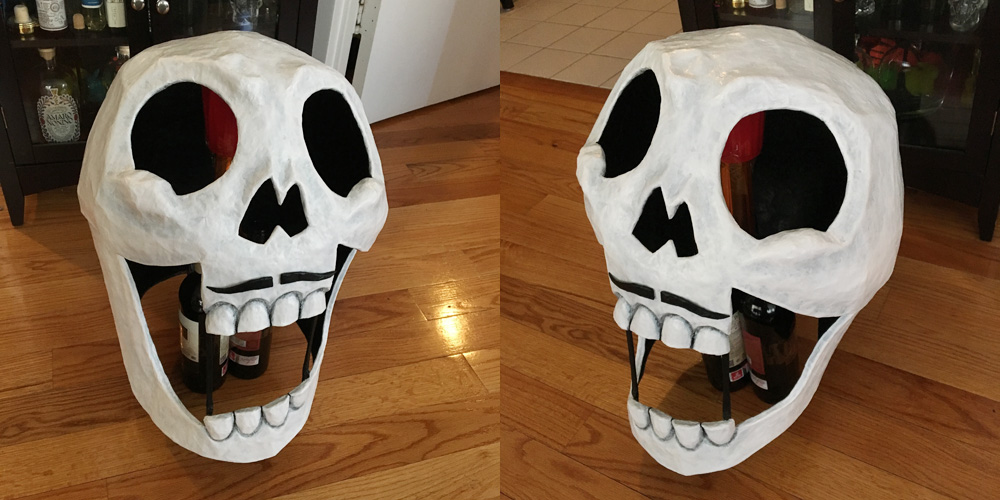
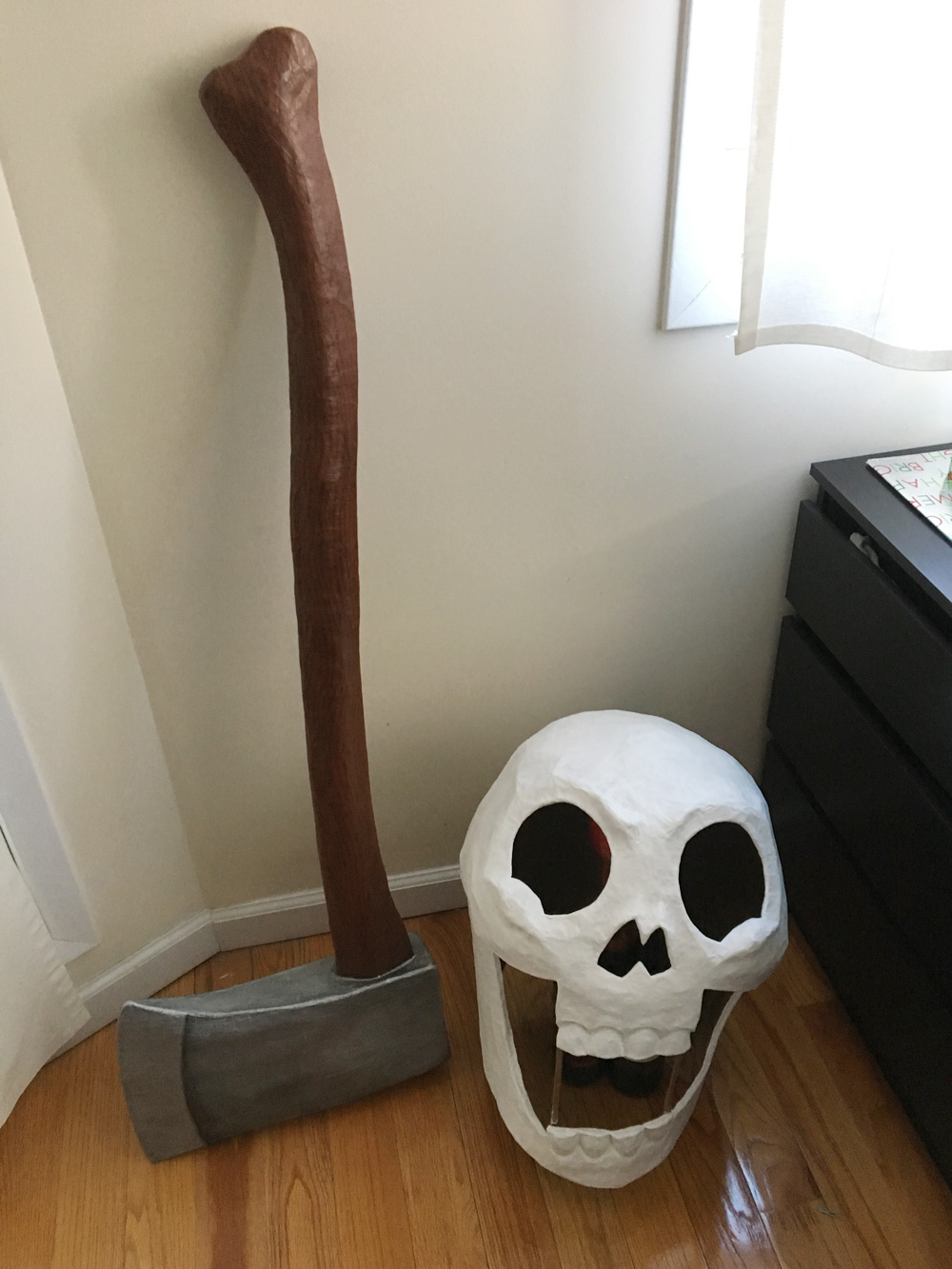


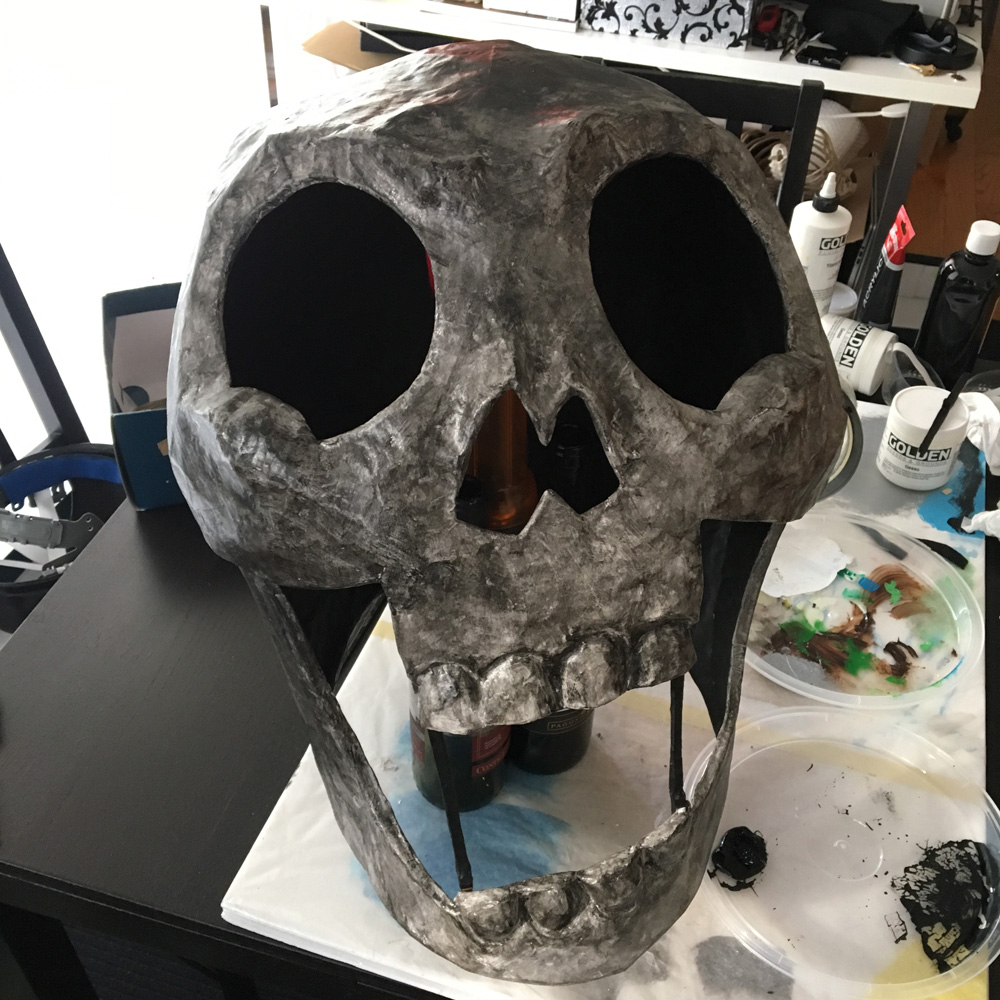
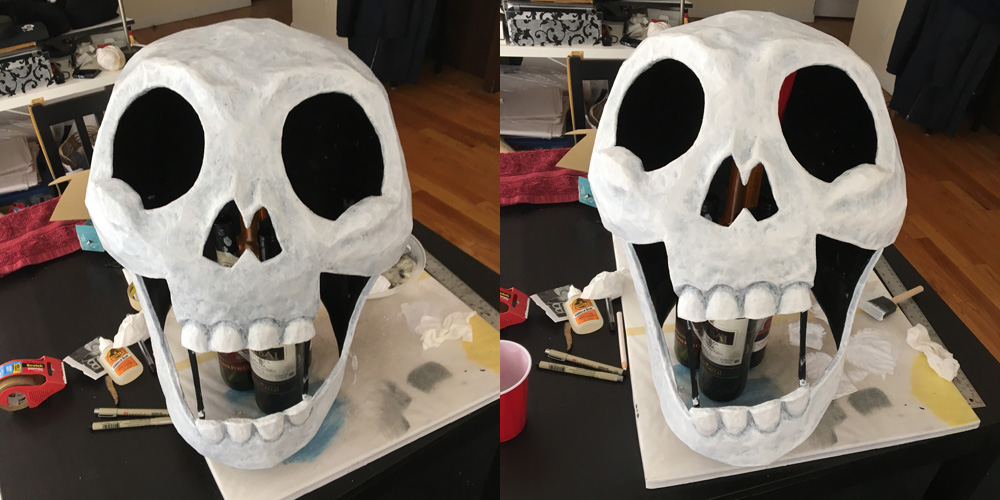

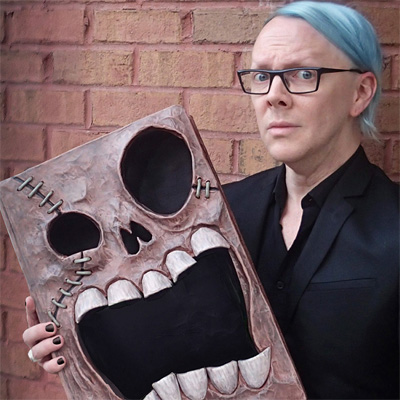 About Manning Krull
About Manning Krull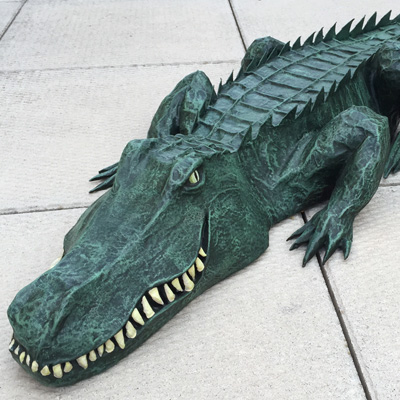 How to make a 4-foot paper maché alligator
How to make a 4-foot paper maché alligator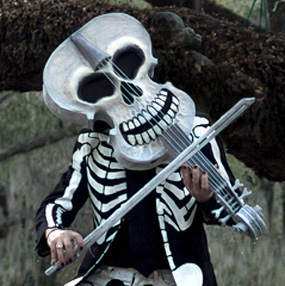 My violin skull mask, Mardi Gras 2015
My violin skull mask, Mardi Gras 2015 Three-headed paper maché dragon sculpture
Three-headed paper maché dragon sculpture
October 29th, 2016 at 5:20 pm
Hello Manning…wow, wow, wow! I am blown away by your talent, so impressive. I’ve been working on my first paper mache project (since childhood) and it is hard! Your posts have been so helpful, thanks so much for that. I have read all of them, some over again and have gotten such great tips. My question is regarding painting…do you always do the black/dirty sponge wash under any project? Or just skeletons? Mine is a bird dinosaur head…wondering if you think it would be beneficial for that? He is spray painted white at the moment..and will be mostly greys and browns with yellow beak. Would love to hear from you :)
Again…you are amazing!!!!!!
Thanks
Laura
October 30th, 2016 at 11:06 pm
Hi Laura! Thanks for your comment. I generally do the black wash with the sponge for all my projects. It really depends on what kind of effect you’re going for! If you want a rough, organic look, then the black wash will help a lot. If you want a bright, solid, less realistic look, then you might not need the black wash. I like using the black wash and white (or whatever final color) dry brushing on all my projects because I like to bring out the texture of the paper mache, as well as the contrast of the highlights and shadows of the shapes, as much as possible. If you’re going for realistic, or semi-realistic, I think you should try it! And fortunately it’s not too hard to start over if you decide you don’t like it. I’d love to see your project when it’s done! Good luck!
November 8th, 2017 at 4:56 pm
Do u ever sell your masks? Can u do a raiders inspired skull mask! Would love to wear on at a game
November 10th, 2017 at 1:50 pm
Hi Jaime! I’ve got a page about my custom paper maché work here. Feel free to get in touch if you’re interested!
April 14th, 2018 at 7:48 pm
Hey, manning. So, I’ve been referring to your website to do my paper mache projects (as of right now, I’m working on my second one), and I was wondering how to make a snout for my fox head. Right now I plan on using a old shoebox, but I wanted to get a experiencedecent persons opinion on this.
Btw, your work is amazing!
April 15th, 2018 at 12:43 pm
Hey Noah! Thank you! I’d love to help if I can. Since you mentioned a shoebox for the snout, I’m assuming your mask is going to be BIG! Back in October I made a very rushed paper mache Anubis mask; link here. I made the basic shapes for the head out of foam board, just cut out and taped together in simple geometric shapes; you can see the head shape in the fourth pic on that page, and you can see that I didn’t measure very carefully because the pieces at the end of the snout didn’t line up right; it didn’t matter ’cause I covered the whole thing with tape and other junk. So, I’m showing you this pic for two reasons: one is to show that a blocky shape is fine! The other is to show how a dog/fox/jackal’s snout is tapered; wider at the back and narrower at the front. If you use a shoebox you’re going to end up with a snout that’s blocky (fine) but not tapered. Depending on how realistic you want to go, this might be fine. One thing you could do if you want a more tapered shape is to slice your shoebox along all four of the long edges, remove the end where the nose would be, and sort of crush that end of the box in on itself, to create a more tapered shape toward the front, and retaining the solid square shape at the back. Here, I made this sketch; the red parts are what you’d cut away. You could then wrap the box with some tape to hold the shape, and if you want to go even further you could use my method of wrapping the whole thing with narrow strips of bubble wrap or craft foam to round out all the edges a bit (also described in the Anubis mask project) and then cover all that with tape before doing the paper mache. It’s a lot of steps but they’re all pretty easy! Good luck!
One more thing; a mask with a snout in the front might be very front-heavy; you can balance it out by taping/gluing lots of pennies inside the back of the mask at the bottom edge!
May 10th, 2018 at 10:06 am
Hi, I am doing a french taunters helmet from monty pythons holy grail. my question is how to paint it. i have spray paint to use. this is the first time i have made anything with paper clay. the helmet is not perfectly smooth. there are quite a few dents! i like the wash idea but i only have the spray paint. help
May 10th, 2018 at 5:11 pm
Hey Sammie! If you have both black and silver (or gray) spray paint, you could try doing a solid coat of black, let that dry, and then do a light dusting of silver/gray (let dry), and then a light dusting of black again (let dry), another light dusting of silver/gray (let dry), etc, until you find a good balance that looks like old beat up metal. You probably won’t be able to emphasize the edges and bumps specifically, like you would with a dry-brush effect, but it should look pretty convincing. Good luck! Now I wanna make one of those snarky French guy helmets too!
May 14th, 2018 at 12:10 pm
well it’s done. it doesn’t look to bad..lol . is there a place i could upload a pic so you could see it?
May 19th, 2018 at 4:13 pm
Hi Sammie! There are a ton of free image hosting sites out there but I don’t know which ones are any good. You could also just email me a pic at manning@manningkrull.com if you want!